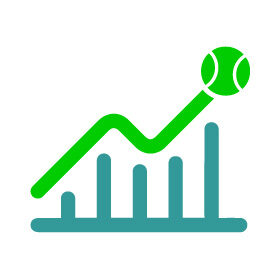Table of Contents
ToggleMoving Beyond Gut Feelings: How Numbers Shape Winning Trades in the Sports Market
The world of sports is electric, full of those nail-biting finishes and moments that make you jump out of your seat. But beyond just being a fan, there’s a whole other game being played: sports trading.
Honestly, it’s a different beast altogether compared to just placing a bet on who you think will win. It’s more like playing the stock market, but instead of stocks, you’re trading bets on sports events, mostly on betting exchanges like Betfair. The real aim? To make money off the shifting odds, those price movements, no matter who actually lifts the trophy at the end.
You’re not just predicting a winner; you’re trying to figure out which way the perceived chances, the odds, are going to swing. In this fast-moving market, being able to spot patterns, figure out probabilities, and make smart calls is absolutely key. And let me tell you, the secret sauce, the thing that separates the consistently successful from the hopefuls, is data analysis. It’s the cornerstone.
Let’s Clear Things Up: Trading vs. Betting
So, what really makes sports trading different from your regular sports betting, or punting as some call it? Well, at its heart, sports trading is about treating it like an investment. You’re looking for profit by buying and selling positions based on changing odds. Think of it like this: on a betting exchange, you can ‘back’ an outcome (betting it will happen) just like a normal bet, but crucially, you can also ‘lay’ an outcome (betting it won’t happen). This back-and-lay functionality means you can potentially profit whether odds go up or down. The goal is simple: get in at one price and get out at a better one, pocketing the difference. It’s not just about being right about the final score.
Traditional betting is often more about the fun of it, supporting your team, or just adding a bit of spice to the game. Sports trading, though? It’s a serious business. Traders actively manage their positions, often getting out early to lock in a profit or cut a loss if things aren’t going their way. You don’t just place your bet and wait for the final whistle like a traditional punter. Plus, the platforms are different. Betting exchanges are marketplaces where you bet against other people, not a bookie. They usually offer better odds because they don’t build in the same kind of margins as traditional bookmakers, and they generally don’t limit winning accounts. It’s a more sophisticated, analytical game.
Why Data is Your Best Friend
Okay, let’s talk about why data analysis isn’t just helpful in sports trading – it’s fundamental. It’s what allows you to move past guesswork and hunches and start making decisions based on actual evidence. By digging into the numbers, you can uncover those subtle trends and patterns that others miss. It gives you a solid grasp of how the market works, helping you fine-tune your strategies and make sharper calls.
One huge benefit? Spotting ‘value bets’. These happen when the odds offered by the market don’t quite match up with the real probability of something happening. Through careful analysis – looking at stats, historical data, maybe even weather patterns – you can identify these gaps.
Finding trades where the potential payout is better than the implied risk is how you gain that crucial edge over time. Seriously, relying on verifiable data like player stats or team history moves you away from pure speculation and brings hidden trends to light. Data analysis basically fuels profitability, turning sports trading from a gamble into a strategic, analytical pursuit.

What Kind of Data Are We Talking About?
The fuel for this analytical engine is a whole heap of different data types. First up, you’ve got your bread-and-butter: team and player performance stats. We’re talking win/loss records, goals scored, player efficiency, historical matchups – the lot. Digging into these helps you understand strengths, weaknesses, and current form. Is a team historically strong at home? Is a striker on a hot streak? This stuff helps gauge likelihoods and spot where the market odds might be off. You can find extensive sports statistics on sites like ESPN Stats & Info.
Then there’s historical betting odds data. Looking at how odds moved in the past in response to certain events, like a key player getting injured or a goal being scored, reveals market tendencies. Understanding this history helps you interpret current market moves and anticipate reactions, potentially finding recurring profitable patterns.
And if you’re into in-play trading? Real-time match data is your lifeblood. Live updates on possession, shots on target, expected goals (xG), injuries, substitutions, it all matters. This instant info lets you react quickly as the game unfolds and odds fluctuate. Picture this: a team is dominating, creating loads of chances (high xG) but hasn’t scored yet. Their odds might still be relatively high, offering a potential entry point before the market fully catches on. Sites like Opta (part of Stats Perform) are leaders in providing such detailed live data.
Don’t forget external factors either. Weather can impact playing styles. Injuries and team news are massive. Even referee stats – do they give out cards easily? – can play a part. Bringing these elements into your analysis gives you a more complete picture, helping you spot things the wider market might miss. Lastly, the betting market data itself is revealing. Where’s the money going (betting volumes)? How are the odds shifting? This tells you about public sentiment and can highlight potential overreactions or mispricings. A sudden flood of money on an underdog might signal something a sharp trader can use.
The Tools of the Trade
So, how do traders actually make sense of all this data? They use a mix of techniques and tools. Basic statistical analysis is key. This means probability analysis, figuring out the likelihood of events and comparing that to the market odds. If your analysis says something is more likely than the odds suggest, bingo, potential value. Regression analysis helps understand how different factors – injuries, weather, home advantage – affect results by looking at historical data. Using statistical distributions like binomial (for win/loss scenarios) or Poisson (for things like goals scored) adds more nuance.
Then you step up to predictive modeling. These techniques use historical data and fancy algorithms to forecast outcomes. Think machine learning models that learn and adapt, neural networks for complex patterns, or Monte Carlo simulations that run thousands of scenarios. These can uncover really complex relationships in the data that simpler methods might miss. Machine learning and algorithms are seriously changing the game. They automate analysis, adapt on the fly, and help pinpoint those value bets where the calculated probability differs from the offered odds. It’s powerful stuff.
Of course, traders need software too. Good old spreadsheets like Excel or Google Sheets are great for basic number crunching. For more complex stuff, statistical programming languages like R or Python are popular. And then there are specialized sports analytics platforms and trading software that offer real-time data feeds, charting, one-click betting, and even automated trading based on your rules. Choosing and using the right tools makes a massive difference to efficiency and effectiveness.
The Payoff: Real Advantages
Putting in the work with data analysis brings tangible rewards. A big one is spotting those market inefficiencies we talked about. When odds don’t reflect true probabilities, that’s your chance. Maybe analysis shows a team’s odds are way better on one exchange, or perhaps the market overreacts wildly to a star player’s injury news, skewing the odds temporarily. Data helps you see and exploit these moments.
It also flat-out improves your prediction accuracy. Data-driven models simply give you a more precise handle on the likelihood of different outcomes, whether it’s the final score or individual player performance. Knowing a player’s history against a specific opponent might give you a much better forecast for the upcoming match. Better predictions naturally lead to more profitable decisions over the long haul.
And let’s not forget risk management – absolutely crucial. Data analysis helps you assess probabilities more accurately, which means you can make smarter choices about how much to stake on a trade. It helps set sensible stop-losses (points where you automatically exit a losing trade) and manage your overall bankroll more effectively. Honestly, this disciplined, data-informed approach to risk is vital for surviving and thriving in the volatile world of sports trading.
It’s Not Always Smooth Sailing: Challenges Exist
Now, it’s not all sunshine and roses. There are definitely hurdles. Getting your hands on accurate, reliable, and complete data can be tough – and sometimes expensive. Inconsistent or incomplete data? That leads straight to bad analysis and poor decisions. Garbage in, garbage out, as they say.
And then there’s the human element. Sports are unpredictable! Data tells you about the past, but it can’t perfectly predict player motivation, freak injuries, controversial ref calls, or sudden shifts in team morale. These things can throw even the best models off course. You also need context. Relying only on stats without considering things like coaching changes or team chemistry can be a mistake. Plus, there’s a risk of ‘overfitting’ models – making them great at explaining past data but useless for predicting the future. Data is a tool, a powerful one, but it doesn’t replace good judgment and understanding the sport itself. We also need to think about the ethical side – data privacy for athletes and ensuring fairness as analytics become more powerful.
Looking Ahead: The Future is Data-Driven
So, what’s next? The role of data analysis in sports trading is only going to grow. Expect more Artificial Intelligence and machine learning, leading to even smarter predictions and maybe more automated trading. Real-time data analysis will get faster and deeper, especially with wearable tech giving us live insights into player physiology and fatigue.
Making sense of all this complex data will rely heavily on better data visualization tools – think interactive charts and dashboards that make trends instantly clear. And we’ll likely see even more specialized software platforms designed just for sports traders, integrating data, analysis, and execution seamlessly.
Wrapping It Up
Ultimately, data analysis isn’t just an option in sports trading anymore; it’s pretty much essential for anyone serious about making consistent profits. Understanding the difference between trading and betting, knowing what data matters, using the right analytical tools – this gives you a real edge.
Yes, there are challenges like data quality and the sheer unpredictability of sports. But the benefits – finding those market inefficiencies, making sharper predictions, managing risk better – make it worthwhile.
The success stories are out there. As technology like AI advances, data’s role will only become more central. For anyone involved in sports trading, embracing a data-driven mindset is key to navigating this complex market and improving your chances of success. Keep learning, keep analyzing, keep refining – that’s the path forward.





